Physical Address
304 North Cardinal St.
Dorchester Center, MA 02124
Physical Address
304 North Cardinal St.
Dorchester Center, MA 02124
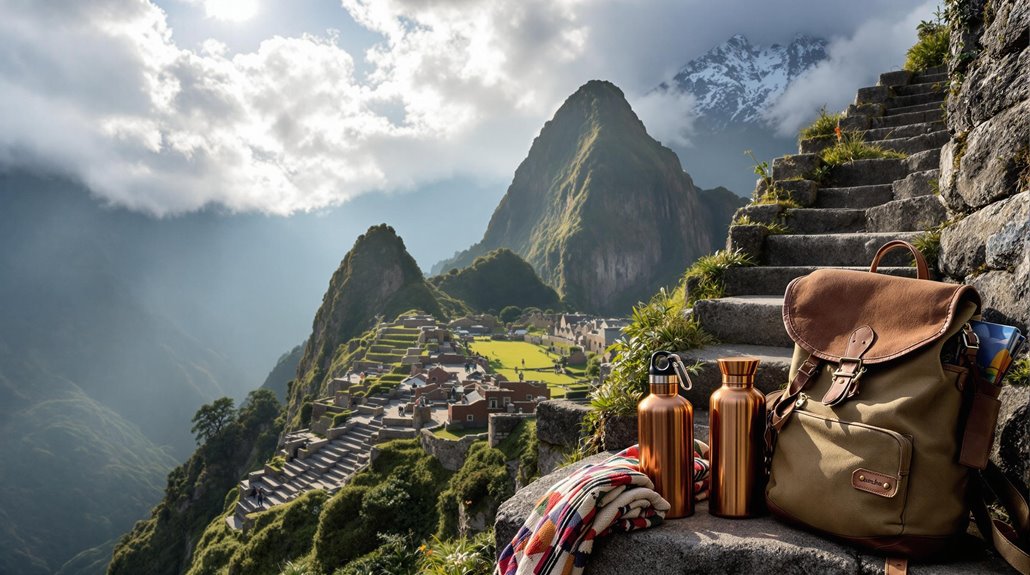
You're about to commence your first South American adventure, and you'll need more than just a passport and a sense of wanderlust. Whether you're planning to trek through Patagonia or explore the lively streets of Rio, knowing the right tips can make the difference between a smooth journey and unnecessary headaches. From steering through local transportation to choosing safe accommodations, these practical insights will help you craft an unforgettable experience while avoiding common first-timer mistakes.
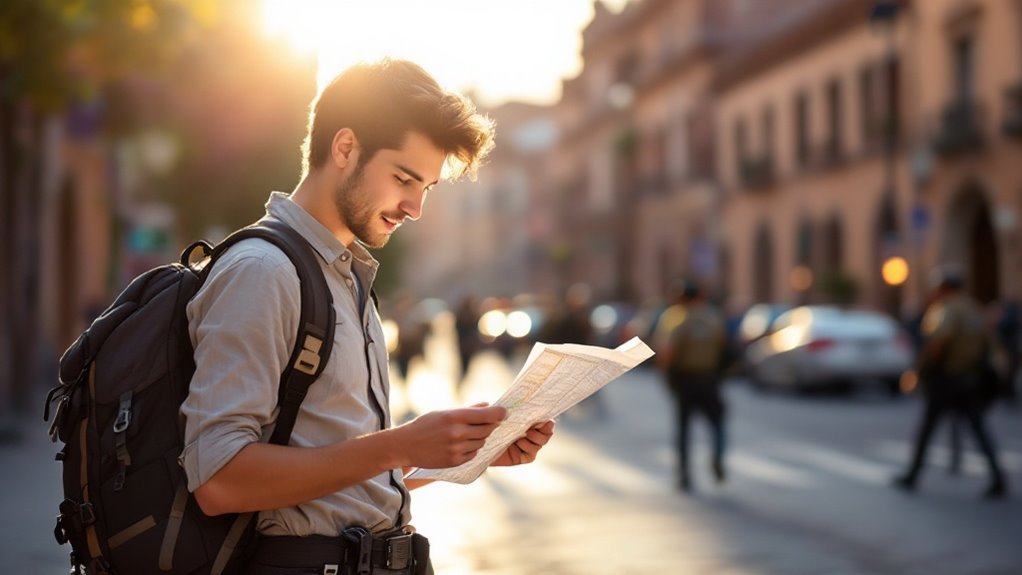
Three key aspects define safety when traveling in South America: preparation, awareness, and adaptability. Before departure, research bus companies thoroughly, pre-book airport transfers, and save local emergency numbers. Learning some basic local language will help navigate unfamiliar situations more safely. Carry travel insurance and keep digital copies of important documents.
During your trip, protect your belongings by using anti-theft bags and room safes for valuables. Don't display expensive items, and carry a decoy wallet with minimal cash. Stay alert in crowded areas and avoid isolated zones after dark.
When using transportation, opt for official taxis or reliable ride-sharing apps, and choose daytime over night travel when possible. Travel in groups when you can, establish meeting points, and share your itinerary with trusted contacts.
Trust your instincts and stay informed about local conditions.
Learning basic Spanish and Portuguese phrases can transform your South American travel experience from confusing to comfortable. Start with essential greetings like "Hola" or "Bom dia," and always include "por favor" and "gracias/obrigado" to show respect.
Language opens doors. Master a few local greetings and polite phrases to bridge cultural gaps and create meaningful connections abroad.
Master key phrases for navigation: "¿Dónde está?" helps you locate places, while "Estoy perdido" signals when you need assistance. Credit cards may not be accepted everywhere, so it's wise to ask "¿acepta tarjeta?" before dining or shopping.
For dining, learn "una mesa para dos" and "la carta" to handle restaurant basics. Don't forget "¿Cuánto cuesta?" for shopping and "la cuenta" when ready to pay.
Download Google Translate's offline mode and practice with Duolingo before your trip. Remember, even imperfect attempts at local languages combined with a smile can greatly improve your interactions.
Plus, knowing terms like "sin gluten" guarantees your dietary needs are met.
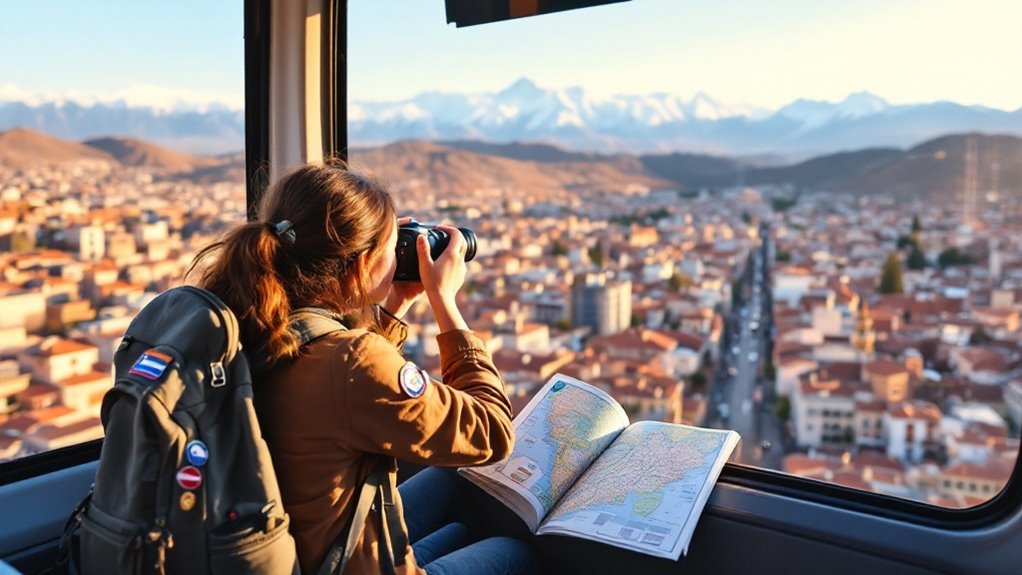
Beyond mastering local languages, getting around South America demands smart transportation planning.
For long-distance travel, you should consider choosing between comfortable buses and strategic flights. Book cama or semi-cama buses with reclining seats for overnight routes, and stick to reputable companies like Cruz del Sur or Civa. Consider bringing basic medical supplies for emergencies during extended bus trips.
For distances over 500 miles, consider budget airlines like Sky Airline or Viva Air – just book 2-3 months ahead for the best deals.
You may discover colectivos (shared vans) perfect for shorter trips under 4 hours. When crossing borders, carry physical copies of your documents and pre-purchase tickets through established companies like Andesmar.
Always prioritize safety by choosing GPS-tracked buses, storing valuables securely, and using only registered taxis in major cities.
While South America's diverse climates can challenge even seasoned travelers, mastering your packing strategy will help you navigate everything from the steamy Amazon to the frigid Andes.
Start with a versatile layering system: pack moisture-wicking base layers, a lightweight fleece mid-layer, and a waterproof shell that can handle intense Andean rainfall. Since winter drops can be severe in southwestern regions, these layers become essential between June and August.
Layer smart in South America – moisture-wicking base, fleece mid-layer, and waterproof shell protect against unpredictable mountain weather.
You'll need quick-dry clothing for 90% Amazon humidity and UPF 50+ protection for equatorial sun exposure. Don't forget sturdy hiking boots for mountain treks and DEET-based repellent for jungle regions.
Choose a 40-60L backpack and use compression cubes to maximize space within airline weight limits. Keep 15-20% of your luggage free for souvenirs, and prioritize neutral colors that work in both urban and rural settings.
Remember to pack portable water filters for remote areas.

Making smart accommodation choices across South America requires understanding the stark contrasts between urban and rural stays. While major cities like Rio and Lima command higher rates averaging $181 per night, you'll discover rural areas considerably more affordable at $11-$40. Monthly stays in rural locations can slash your costs by 50%, perfect for longer adventures. Eco-lodges like Posada Amazonas Lodge demonstrate the incredible value of rural stays through their all-inclusive meals and daily reserve visits. Budget travelers can explore Bolivia's diverse landscape for 7-day trips costing significantly less than other South American destinations.
To maximize your accommodation strategy:
Watch for exceptions like Bolivia, where rural luxury can exceed urban rates.
Smart money management in South America requires a mix of payment methods and heightened security awareness. You'll want to carry USD as a backup, but rely primarily on Visa or Mastercard debit cards for ATM withdrawals and purchases in urban areas.
Mix cards and cash wisely in South America, with debit cards for daily use and USD tucked away for backup.
When using ATMs, withdraw maximum amounts early in the day at bank-affiliated machines to minimize fees. Always check for skimming devices and shield your PIN entry. Digital banking apps provide convenient alternatives with low fees.
Split your cash and cards between multiple secure locations, and use a decoy wallet with minimal funds. For currency exchange, avoid airports and hotels – instead, use local casas de cambio for better rates.
Don't forget to notify your bank of travel dates, and track daily withdrawal limits by country. Keep emergency cash separate from daily spending money, and store excess funds in your hotel safe.
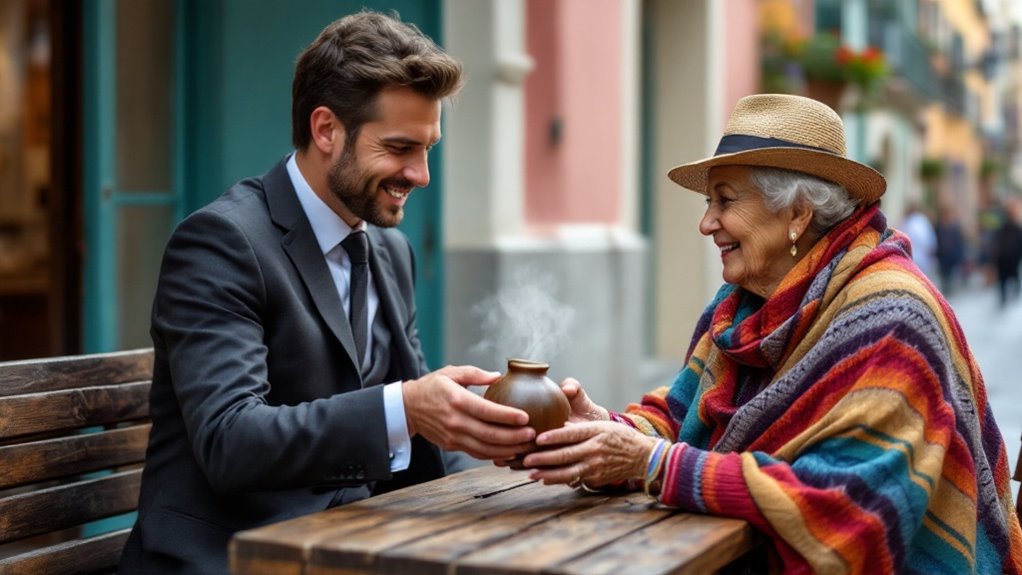
Beyond managing your money safely, understanding South American social norms will help you navigate daily interactions with grace.
Be prepared for more physical contact during greetings, including cheek kisses or handshakes. Always dress formally for dinners and keep your attire elegant even at casual gatherings. When dining, use continental-style eating and accept offered food or drinks to avoid offense. When serving wine, remember to pour with right hand while holding the bottle near the top.
3 essential etiquette tips to remember:
Learn basic Spanish phrases and don't be surprised by personal questions about family or income – it's just friendly conversation, not rudeness.
While exploring South America's lively culinary scene, you'll need to balance adventure with food safety.
When trying street food, choose vendors with long queues and watch them cook your meal fresh. Stick to fruits you can peel yourself, and avoid pre-cut produce that might've been washed in tap water. Many locals prefer visiting morning food markets for the freshest and safest options.
For restaurants, take advantage of lunchtime menú del día specials at upscale venues, and align your dining times with local customs – dinner often starts after 9 PM. Consider exploring regional specialties to experience authentic local flavors.
Use reliable review platforms to find hygienic establishments, and book official taxis for restaurant travel.
Always carry antibacterial wipes for utensils, skip ice in drinks unless it's from purified water, and check that meats are thoroughly cooked.
Keep emergency numbers handy and pack activated charcoal tablets for mild stomach issues.
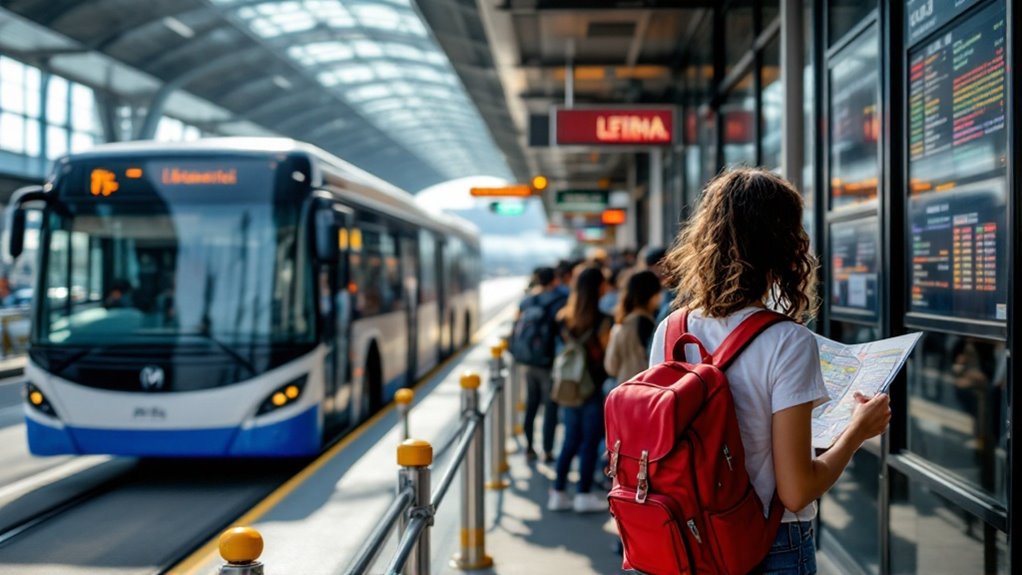
Maneuvering South America's public transit systems requires a mix of planning and flexibility. You'll discover extensive metro networks in major cities like São Paulo and Mexico City, while BRT systems operate efficiently in 54 cities across the region. The capital's Transmilenio system uses dedicated bus lanes to effectively serve Bogotá's 10 million residents.
For budget-conscious travelers, monthly transit passes in cities like Buenos Aires cost just $14-17.
When using public transportation, follow these key guidelines:
Remember that infrastructure quality varies considerably between urban and rural areas, so plan extra time for regional travel.
Before commencing your South American adventure, you'll need to take several essential health precautions.
Visit a travel clinic 4-6 weeks before departure to get required vaccinations like yellow fever, which is mandatory for entering Brazil, Peru, and Colombia. Don't forget hepatitis A/B and typhoid shots. It's important to plan vaccinations 6 to 12 weeks ahead to ensure proper immunity development.
In tropical regions, protect yourself from mosquito-borne diseases by using DEET repellent, wearing long sleeves, and sleeping under treated nets.
Pack a basic medical kit with prescription medications, first-aid supplies, and antidiarrheal medicine. Stay healthy by drinking only bottled water and eating hot, cooked meals rather than raw foods or street fare.
If you're heading to the Andes, consider altitude sickness medication.
Finally, verify your medical evacuation insurance coverage and keep vaccination records handy throughout your journey.
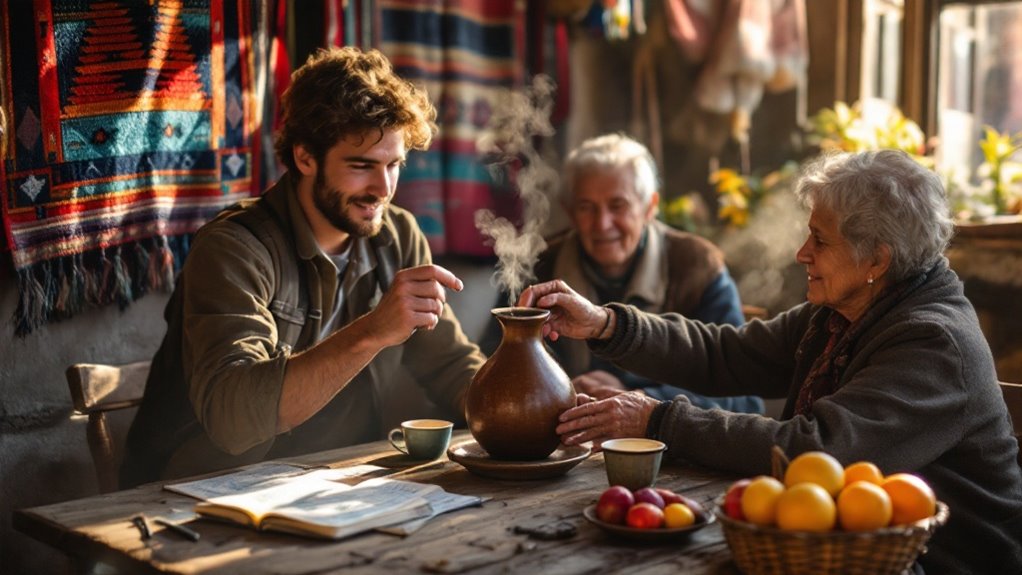
Although South America's iconic destinations can strain your wallet, savvy travelers can discover authentic experiences at a fraction of typical costs.
You'll encounter budget-friendly adventures like the Santa Cruz Trek in Peru for $150-200, compared to pricier alternatives like the Inca Trail. Community-based tourism and local operators consistently offer better value while supporting regional economies. Experience breathtaking views of South America from La Paz cable cars for just $0.70 per ride.
To maximize authentic experiences while saving money:
Consider traveling during shoulder seasons for additional 20% savings on accommodations and fewer crowds at major attractions.
Modern technology makes exploring South America easier than ever before. Download country-specific travel guides like Chile Travel and Peru Travel for detailed destination info, event calendars, and UNESCO site recommendations.
For navigation, Maps.Me and AllSubway provide reliable offline maps and route planning across major cities.
When it comes to getting around, you'll discover Uber and DiDi widely available in metropolitan areas, while RedBus helps you book intercity bus travel. Compare prices and services from over fifty companies through RedBus to find the best transportation options for your journey.
Keep your finances in check with XE Currency for exchange rates and Revolut for fee-free ATM withdrawals.
Don't forget language tools – Google Translate's offline mode will help you decipher menus and signs, while Duolingo can teach you essential Spanish phrases.
For trip organization, use TripIt to consolidate your bookings and PackPoint to create climate-appropriate packing lists.
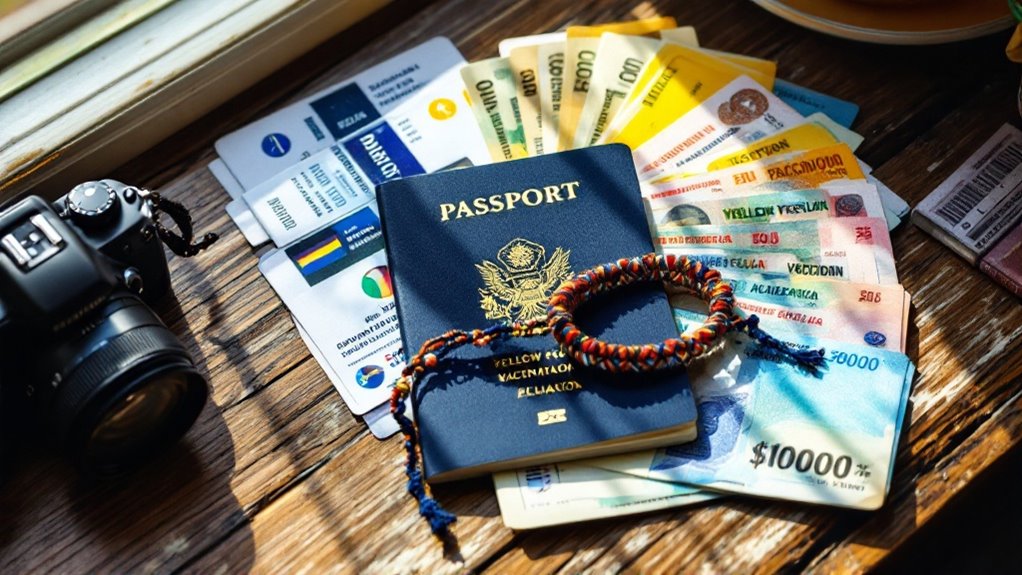
Planning your South American border crossings requires careful attention to documentation and entry requirements.
You'll need a passport valid for at least 6 months with blank pages, plus copies of all essential documents. While most Western travelers get visa-free entry to countries like Peru and Ecuador, you'll need pre-approved visas for Bolivia, Venezuela, Brazil, and Argentina if you're a US citizen. Having laminated document copies can help protect your vital paperwork from loss or damage.
Follow these vital steps when crossing borders:
Remember that visa policies can change quickly, so always verify current requirements through official channels before your trip.
Your first South American adventure doesn't have to be overwhelming. By following these practical tips, you'll navigate the continent with greater confidence and safety. Remember to stay flexible with your plans, keep important documents secure, and maintain awareness of your surroundings. Whether you're exploring bustling cities or remote villages, these guidelines will help you create an unforgettable journey while avoiding common first-timer mistakes.